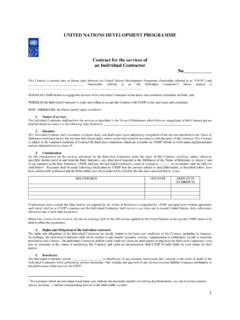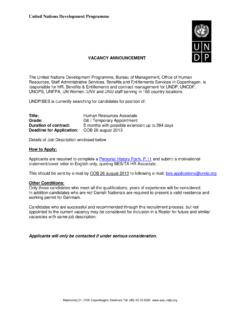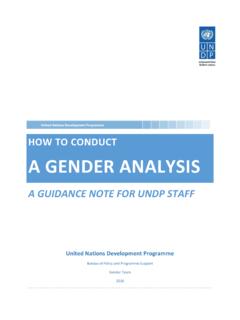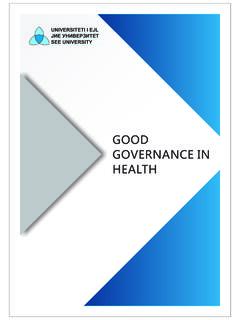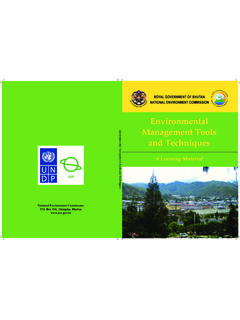Transcription of Turkana County – United Nations Joint Programme
1 Pg. 1 Turkana County United Nations Joint Programme 2015-2018 Turkana County United NATIONSJOINT PROGRAMME2015-2018 Executive Office, Turkana County Government, Lodwar, Turkana UN Resident Coordinator Office, Nairobi, Kenya pg. 3 Turkana County United Nations Joint Programme 2015-2018 1 Background and Programme contribution to Turkana CIDP Implementation Historical background Turkana County occupies much of north-west Kenya. It lies just north of the equator, within the Great Rift Valley and shares boundaries with three other African countries (Uganda to the northwest, South Sudan to the top north and Ethiopia to the northeast). It is also contiguous with four other Kenyan counties (West Pokot and Baringo to the southwest, Samburu to the southeast and Marsabit to the east). Turkana County is one of the largest counties in Kenya, but its 68,680 km2 are rated mainly as semi-arid (19%), arid (42%) or very arid (38%); rainfall is very erratic and averages less than 6 inches of precipitation per year.
2 Temperatures range from 20 to 41oC, with an average of Water availability for people and livestock is a challenge as there are only two permanent rivers and water is mostly obtained from ponds, rock-pools and springs immediately after rain and holes dug progressively deeper in the river beds as the dry season progresses. Lake Turkana forms the eastern border of the County with Marsabit County . It is the largest desert lake and is the most saline lake in the Rift Valley. It is good for fishing and is endowed with a rich wild life. However, it is reported that the Lake s water level dropped by 10 meters between 1975 and 1992 (Ministry of Planning, 2013). This trend, which could be exacerbated by the damming of tributaries such as the Omo River to the north, might have negative environmental impacts that need to be mitigated. Despite these seemingly inhospitable living conditions, the discovery of the Turkana Boy , a human-like fossil dating back million years, suggest this location to be the cradle of humanity.
3 Archaeological evidence from the region has revealed many stone artefacts several million years old, decorated pottery dating back 6000 years BC, and cemeteries and burial mounds estimated to have been established between 355 and 165 BC, suggesting that the region was a major center of human civilization. The European scramble for Africa reached Turkana at the end of the 19th century. It was met with fierce resistance from the Turkana people. Turkanaland was made part of the British East pg. 4 Turkana County United Nations Joint Programme 2015-2018 Africa Protectorate in 1895 and part of Kenya in 1926, but it was put under the Closed Districts Ordinance requiring a special permit to go in and out of Turkana , thus effectively isolating it from the rest of the country. Missionaries who were introducing education and medical facilities elsewhere in Kenya did not reach Turkana until 1956 for the African Inland Mission and 1961 for the Catholics.
4 After Kenya s independence in 1963, the centralized government headquartered in Nairobi was slow in providing basic services of health care, education, housing, roads, agricultural extension and security to this remote part of the country. Fast population growth, an arid landscape hit by increasingly frequent droughts and floods, severe water shortage and lack of grazing land for communities mainly depending on livestock for their livelihoods, have forced pastoralists to venture further and wider in search of pastures, and have increased the occurrence of social conflicts in the form of cattle raiding and other criminal activities between communities. Marginalized and exposed to calamities such as recurrent droughts that make the region food insecure and periodically lead to massive loss of life for people and livestock famine, posting extreme levels of poverty (over 75% below the poverty line) and malnutrition (extremely high at over 30%), Turkana became the obvious target of relief assistance of all kinds.
5 Humanitarian and development interventions in Turkana The first record of relief assistance in Turkana date back to 1934, when the colonial administration distributed cereals to what was then called paupers camps , and to people working on public projects such as locust eradication. Such programs were however limited in scope. Large scale distribution of food aid began in response to the drought of 1960-1961 by the government and humanitarian organizations. Relief centers were established to assist around 30,000 people. With the severe famines of the early 1980s (1979-1980 and 1984-1985), relief assistance was scaled up under the coordination of the Turkana Rehabilitation Project to reach around 85,000 people or about half the population of Turkana District at that time (Humanitarian Policy Group, 2005). Since then, relief assistance through food distributions has somewhat been institutionalised.
6 Centered on the main towns and cities, it has been criticized for creating dependency on food aid and disrupting pastoral livelihoods. Since then, relief assistance providers have diversified their activities to include livestock related interventions such as destocking/restocking, supply of livestock feeds and emergency veterinary programmes, and other livelihoods enhancement projects (Aklilu and Wekesa, 2002). In February 2014, the United Nations and the County Government of Turkana conducted a rapid assessment of development projects in Turkana . The assessment revealed a wide diversity in the range of assistance that was being provided by to Turkana by UN and non-UN agencies (UNDP, 2014). Interventions were registered in the areas of governance and peace pg. 5 Turkana County United Nations Joint Programme 2015-2018 building, food security (including irrigation, water harvesting, fisheries, poultry-keeping, micro-credit access and enterprise development , etc.)
7 , water and sanitation, health and nutrition, education support, vocational training, afforestation and environmental conservation, natural resources management, gender empowerment and social accountability, and media training and sensitization. The conclusion of this assessment corroborated the findings of previous studies and evaluations. In the past 50 years, enormous resources have been deployed in Turkana but the impact generated was not commensurate with the volume of resources. It was imperative to implement a paradigm shift in the conceptualization, formulation and implementation of humanitarian and development activities in Turkana in order to achieve greater efficiency, generate more impact and ensure sustainability of positive results. This new direction was endorsed by the Turkana County leadership and led the United Nations Country Team to propose the formulation of a special program for Turkana development that would be tailored according to its own UNDAF, in line with the County s strategic development plan and the country MTP-2, and in close cooperation with development interventions by other actors.
8 All UN entities planning activities in Turkana County would formulate their activities in the context of and in harmony with the proposed overall UN support program. This push for greater coordination in the delivery of humanitarian and development activities echoed efforts being undertaken at the national government level. In 1998, an act of parliament established a National Disaster Operation Center to coordinate response to emergencies and disasters at the national level. A draft national disaster management policy was later formulated in 2002, but is yet to be finalized. And in 2011, the National Drought Management Authority was established to put in place mechanisms at national and County levels which ensure that drought does not result in emergencies and that the impacts of climate change are sufficiently mitigated. This new development is in response to the 2010 Constitution of Kenya which requires that the government takes necessary measures to achieve the progressive realization of the rights under Article 43, including the right to be free from hunger.
9 A new dawn for Turkana County : The Integrated development Program The 2010 Kenya Constitution introduced a two-tier system of government, with a national and a local administration sharing responsibilities for providing services to citizens and managing the country development process. The local administration was divided between 47 counties, including Turkana County . The elections of March 2013 ushered in the local administration envisaged by the 2010 Constitution including a Governor, Deputy Governor and a County Assembly. County governments were requested to formulate their strategic development plans in tune with the national Vision 2030 and second Medium Term Plan (MTP-2). Turkana County launched its Integrated development Plan (CIDP) on 11 September 2014. The CIDP, which aims to make the County a prosperous, peaceful and just County with an empowered community enjoying equal opportunities, is a comprehensive blue print that will guide the County Government and development partners engagement in Turkana County in pg.
10 6 Turkana County United Nations Joint Programme 2015-2018 order to realize the social economic transformation of its people. Developed through a comprehensive consultative process to address the glaring levels of underdevelopment in the County and emphasize development interventions that would reduce the need for humanitarian responses, the CIDP has identified 11 priority sectors within the 14 devolved functions under the control of the County government for the period 2014-2017. According to the County Governor, the implementation of the CIDP will emphasize coordination of all development actors in order to reduce duplication of efforts, encourage private sector entities already active in the County and invite new ones to tap into the huge investment opportunities available in the County . Having supported the formulation of the CIDP, the United Nations System in Kenya is committed to supporting the aspirations of the Turkana people contained in the CIDP.

